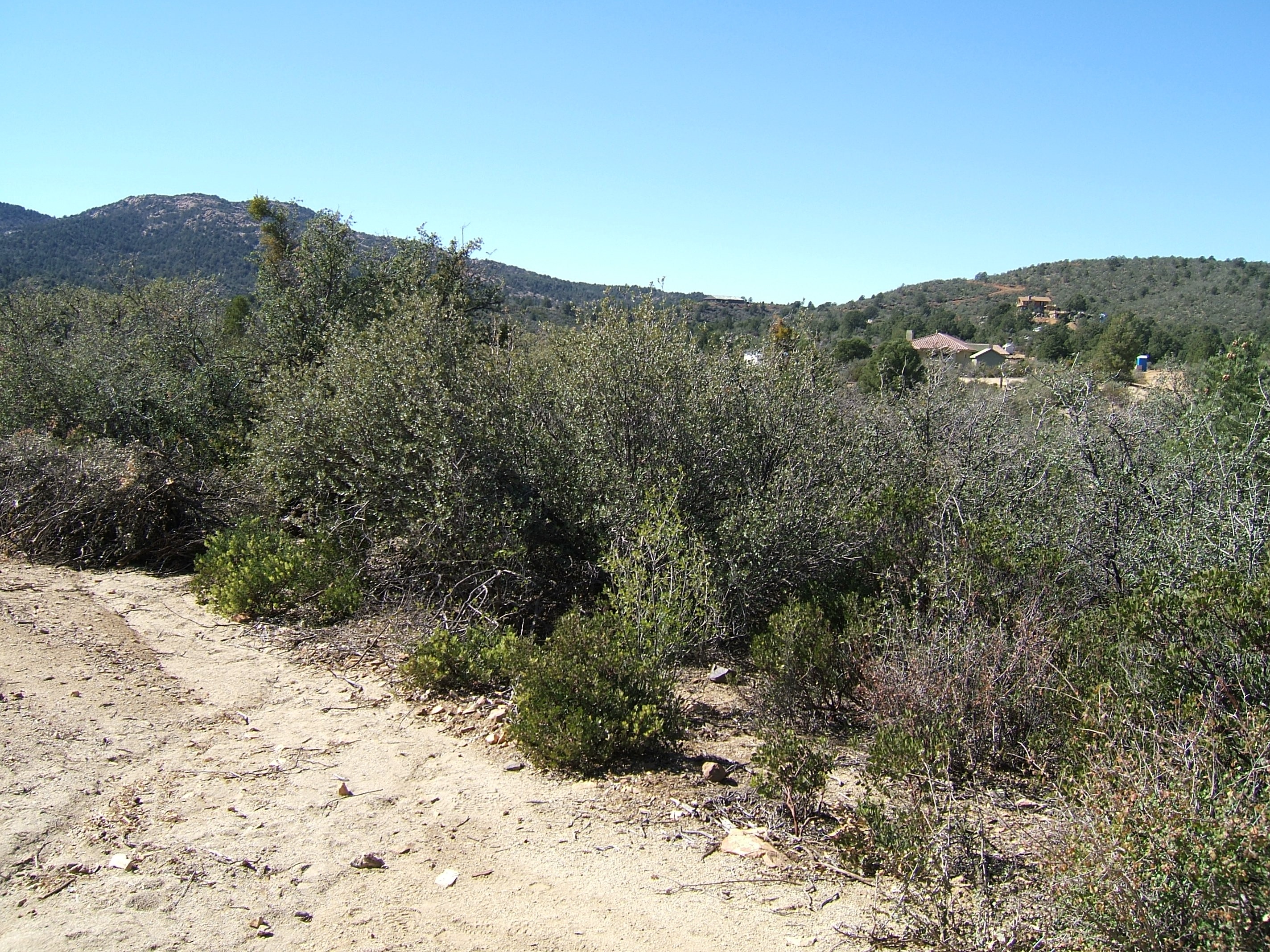 Arizona’s Interior Chaparral - June 22, 2016 Jeff Schalau, Agent, Agriculture & Natural Resources University of Arizona Cooperative Extension, Yavapai County Chaparral is a word used to describe a shrub-dominated plant community. Chaparral communities cover approximately 3.5 million acres in Arizona. You may find areas of this unique vegetative community at elevations between 3,200 and 5,700 feet running between the northwest corner and the southeast corner of Arizona. The topography where it occurs is mostly on rough terrain dominated by coarse textured and/or poorly developed soils. Many chaparral plants have one or more of the following characteristics: woody branches, leathery leaves, spines, and high resin content. In and around the Verde Valley, you can find chaparral on the slopes of Mingus Mountain and the Black Hills as well as the drier areas of Sedona. These areas are often difficult to hike in without developed trails. The most common species in Arizona interior chaparral is scrub live oak (Quercus turbinella) which often occurs in almost pure stands. Other common chaparral shrubs include: mountain mahogany (Cercocarpus ssp.), skunkbush (Rhus trilobata), sugar sumac (Rhus ovata), silktassels (Garrya spp.), desert ceanothus (Ceanothus greggii), hollyleaf buckthorn (Rhamnus ilicifolia), cliffrose (Purshia mexicana), desert olive (Forestiera neomexicana), Palmer oak (Quercus palmeri), and manzanita (Arctostaphylos spp.). Trees can sometimes be interspersed with the shrubs. These are often Arizona white oak (Quercus arizonica), Emory oak (Quercus emoryi), pinyon pine (Pinus edulis) and Juniper (Juniperus spp.). Arizona receives its precipitation in two seasons: winter and summer. This bimodal precipitation pattern causes Arizona chaparral plants to maintain somewhat consistent moisture contents. This is important when examining the timing and intensity of wildfires. Studies have shown the natural fire return intervals (the number of years between natural wildfire ignitions) in central Arizona chaparral were between 20 and 40 years prior to European settlement. This indicates a minimum of 20 years regrowth is required for it to re-burn. Since European settlement, fire suppression has kept many areas, including chaparral areas, from burning as frequently and has allowed deadwood to accumulate thereby increasing the intensity of wildfire when it occurs. Following fire, many of the Arizona chaparral shrubs quickly resprout from established root crowns. In other plants such as Manzanita, fire stimulates germination of seeds (scarification) that have long been buried in the soil. Scrub live oak tends to remain spatially stable (respouting vigorously after fire) on sites where it grows. In studies of repeat photography, Arizona stands of scrub live oak that were present over 100 years ago persist in almost exactly the same height and spatial distribution present today. Several wildlife species utilize chaparral vegetation for habitat. Big game species include javelina, deer, and bighorn sheep. Quail, vireos, towhees, and other ground dwelling bird species are also dependent on chaparral ecosystems for cover and food. Rabbits and small rodents also utilize chaparral habitats. Snakes and lizards are also chaparral residents. Predators such as mountain lions, coyotes, bobcats, foxes, and various birds of prey can also be found in chaparral looking for a meal. This may be somewhat challenging given the tangled limbs and thorny plants that create an almost impenetrable barrier. Chaparral areas are often used for rural home building sites and can pose serious wildfire risk if vegetation is not drastically reduced in density and distribution near the home. In these settings, islands of chaparral are acceptable given they are 30 or more feet from any flammable structure. In these situations, a homeowner may decide to permanently kill a selected number of plants. Digging out chaparral plants is laborious and may be ineffective. Applying appropriate herbicides to cut stumps is an effective way to permanently kill unwanted plants and reduce wildfire risk in and adjacent to Arizona chaparral. The third year anniversary of the loss of the 19 Granite Mountain Hotshots in the Yarnell Hill Fire will be on June 30, 2016. These firefighters lost their lives partly because of the fire’s intensity, weather conditions, and other factors. The Granite Mountain Hotshots were also surrounded by dense chaparral without an available escape route when they perished. This unfortunate loss of life is a reminder of the risks firefighters face living in rural Arizona. Home and property owners living in or near chaparral areas must take extra care to develop wildfire defensible space which, in turn, will aid firefighters should they be called to protect these areas. Follow the Backyard Gardener on Twitter – use the link on the BYG website. If you have other gardening questions, call the Master Gardener help line in the Camp Verde office at 928-554-8992 or e-mail us at verdevalleymg@gmail.com and be sure to include your name, address and phone number. Find past Backyard Gardener columns or provide feedback at the Backyard Gardener web site: http://cals.arizona.edu/yavapai/anr/hort/byg/.  A view of Arizona interior chaparral near Prescott, AZ.
A view of Arizona interior chaparral near Prescott, AZ. |